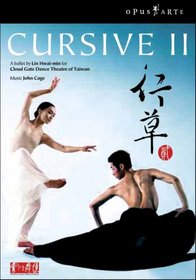| Actors: John Cage, Taiwan Ballet Theater, Lin Hwai-min Genres: Music Video & Concerts, Special Interests, Musicals & Performing Arts Sub-Genres: DTS, Dance, Classical, Ballet & Dance Studio: BBC / Opus Arte Format: DVD - Color,Widescreen - Subtitled DVD Release Date: 05/16/2006 Theatrical Release Date: 04/03/2006 Release Year: 2006 Run Time: 2hr 27min Screens: Color,Widescreen Number of Discs: 1 SwapaDVD Credits: 1 Total Copies: 0 Members Wishing: 1 Edition: Classical MPAA Rating: NR (Not Rated) Languages: English Subtitles: Dutch, English, French, Italian, Spanish |
Search - Cursive II / Lin Hwai-min, Cloudgate Dance Theatre of Taiwan on DVD
Movie Details
We're sorry, our database doesn't have DVD description information for this item. Click here to check Amazon's database -- you can return to this page by closing the new browser tab/window if you want to obtain the DVD from SwapaDVD.
Click here to submit a DVD description for approval.
Similar Movies
|
Movie ReviewsA new language of dance Sackerson | Canada | 08/14/2008 (5 out of 5 stars) "Lin Hwai-min's Cloud Gate Dance Theatre provides a new language of dance for anyone who has not seen them perform before. I watch a great deal of dance from classical to contemporary, and while there is much that is familiar in the dance vocabulary of this company to anyone who knows the work of Jiri Kylian, Mats Ek, Carolyn Carlson, or Angelin Preljocaj, there is also much that is new. The western dance influences borrowed by Mr Lin are subsumed in positions and movements from Tai Chi and martial arts, as well as from the Beijing Opera, with the result that the dance is fresh, arresting, and sublimely beautiful.
I found myself wondering how the best dancers from the western tradition -- Gillot, Ganio, Durante, Baryshnikov, for example -- would view these dancers with their extraordinary extensions, their almost contortionist flexibility, and their electrifying ability to freeze instantly into a position which looks completely untenable and hold it for what seems minutes at a time. Technically, the Cloud Gate dancers are remarkable -- although their technique is so infused with elements other than those of western contemporary dance or ballet that it is difficult to judge it analytically. It is rather like listening to poetry read in a language one does not know, or doesn't know well: certain elements (sonality, metre, inflection) may be judged, but the overall effect is simply beyond one's ken, and in the end one must simply experience and wonder. Certain stylistic points can be made which might help others considering this DVD. First, there is practically no contact between the dancers: they tend to work in positions close to one another but not touching, and the movements are often "counterpointed". For example, one dancer might be moving very quickly through a series of gestures and positions while another, or others, remain still or move slowly in contrast. Second, in general (at least in this piece) the main line of the dance is low -- say at waist height: most of the movements generate from the waist or are effected with the feet firmly planted. One typical resting or transitional position has the legs wide apart, knees bent, the feet planted, and the hands placed on the thighs, giving a rooted, solid effect. Both the women and the men are dressed in long, loose, widely cut pants of light translucent material (men in black, women in white) with the men naked to the waist and the women wearing flesh-coloured leotard tops. This throws the emphasis on the upper body and arms, and gives the effect of the lower body's being the foundation of the dancer: there is, in other words, very little of the delicate use of the foot which one finds in ballet -- no entrechats, no pointe -- although the occasional stretchings-out of the feet are lovely. The dancers are barefoot. Even the jumps are kept low to the floor, although they include some fairly hair-raising flips. The music by John Cage, selected from a number of his works, provides a perfect accompaniment. If one didn't know its origin, or know Cage's work otherwise, it could easily be mistaken for music by a Chinese or Japanese contemporary composer, although it hasn't the textural delicacy of a Takemitsu, for instance. It does provide a good deal of space -- silence -- between notes or passages, and this fits well with the style of the choreography, which seems to seek points of rest and then move swiftly into successions of movement. The subject of the piece, Chinese classical calligraphy, also of course relies on a contrast, in that case between the blackness of the ink and the whiteness of the paper on which it appears -- a point Mr Lin makes strikingly in his discussion of the piece both in the twenty minute introduction, and in the later hour-long documentary about him and the company. These are both fascinating and essential viewing. I would particularly suggest watching the introduction before seeing the dance itself. All in all, I found this a delightful, stirring, and ravishingly beautiful experience. It will surely provide deep pleasure to any lover of modern dance particularly, but really to any open-minded lover of dance in any of its forms. I am determined to add the other available DVDs of the company to my collection as soon as possible." |






![Enron - The Smartest Guys in the Room [Blu-ray]](https://nationalbookswap.com/dvd/s/10/9910/99910.jpg)